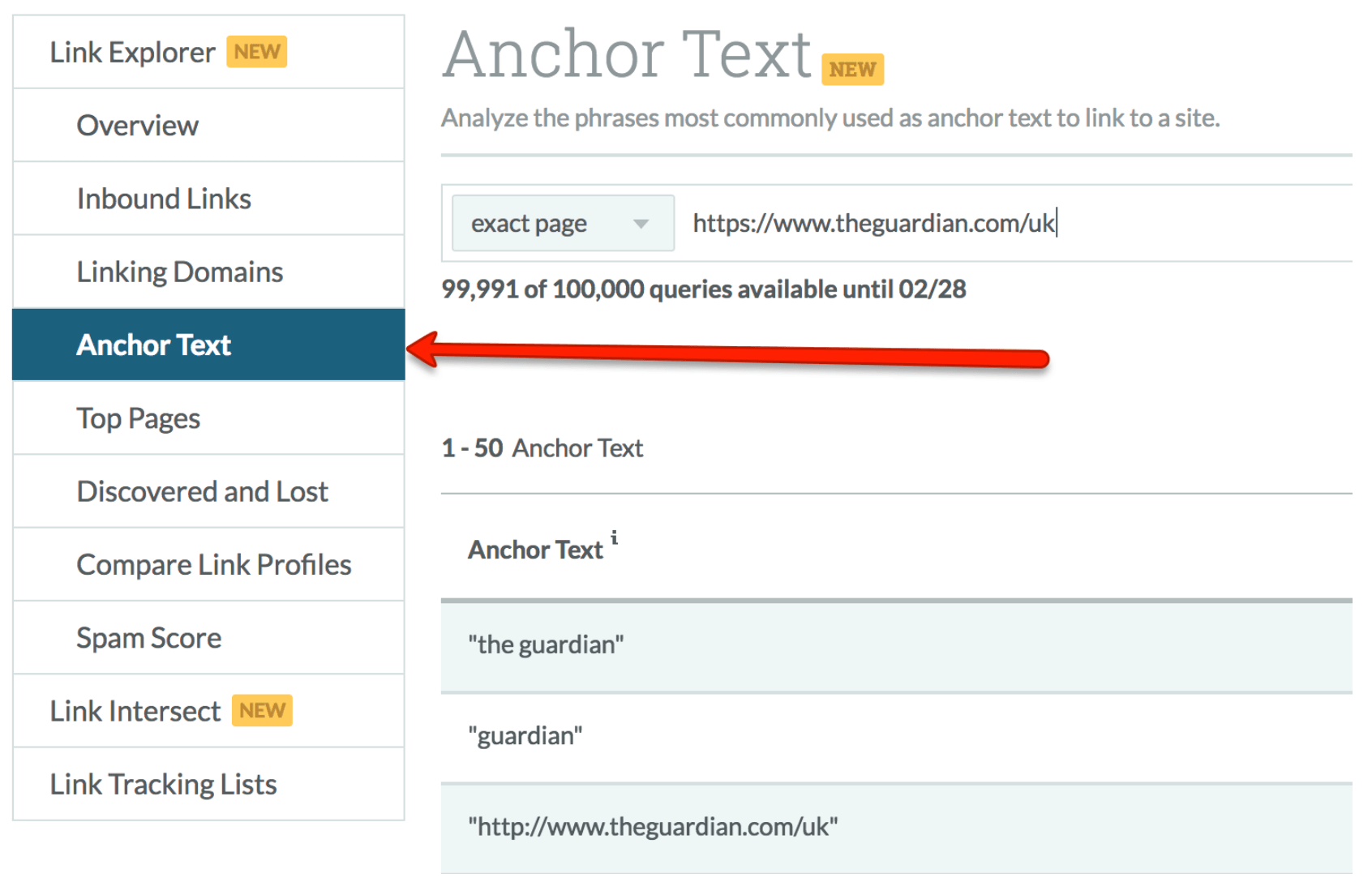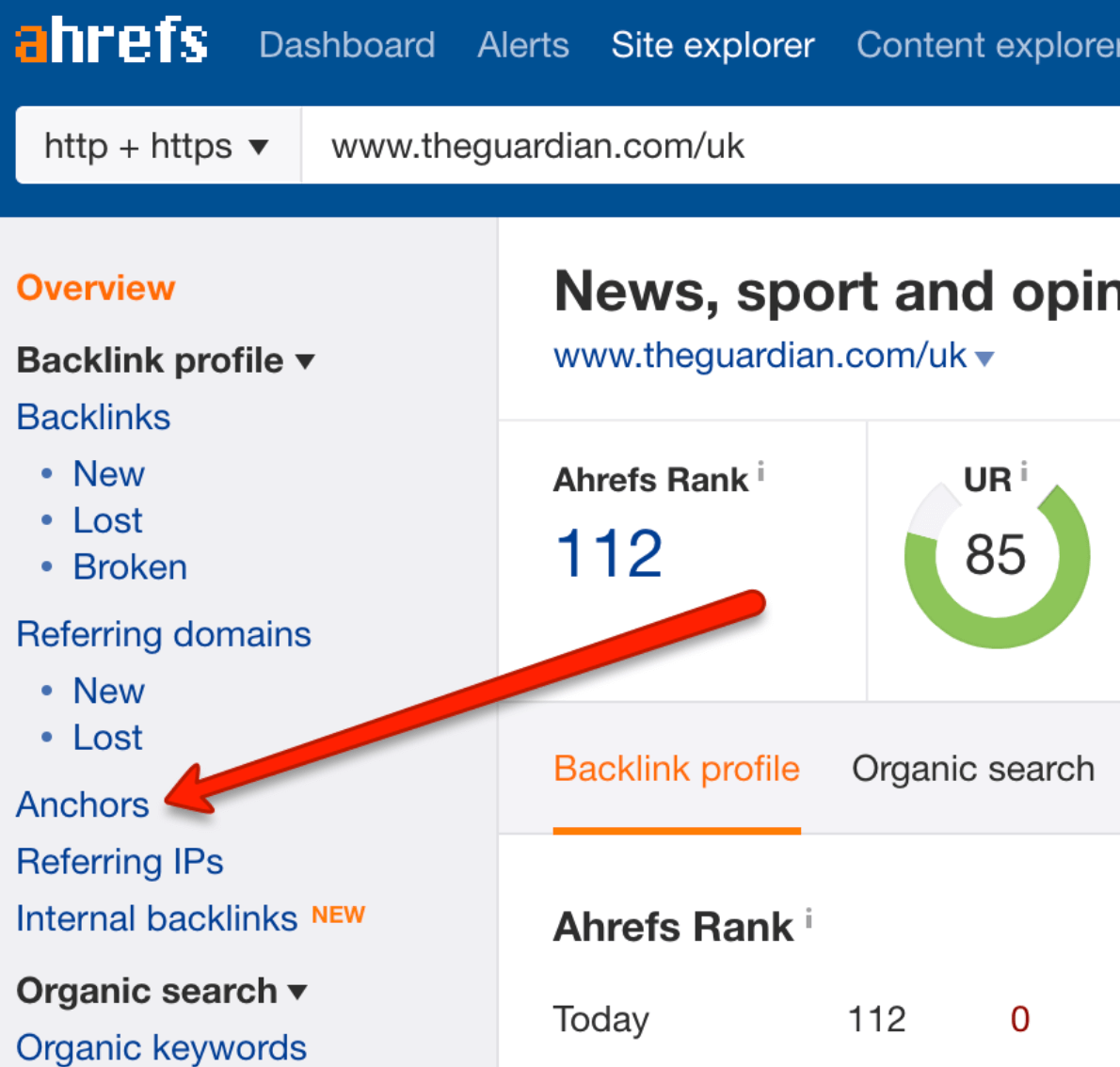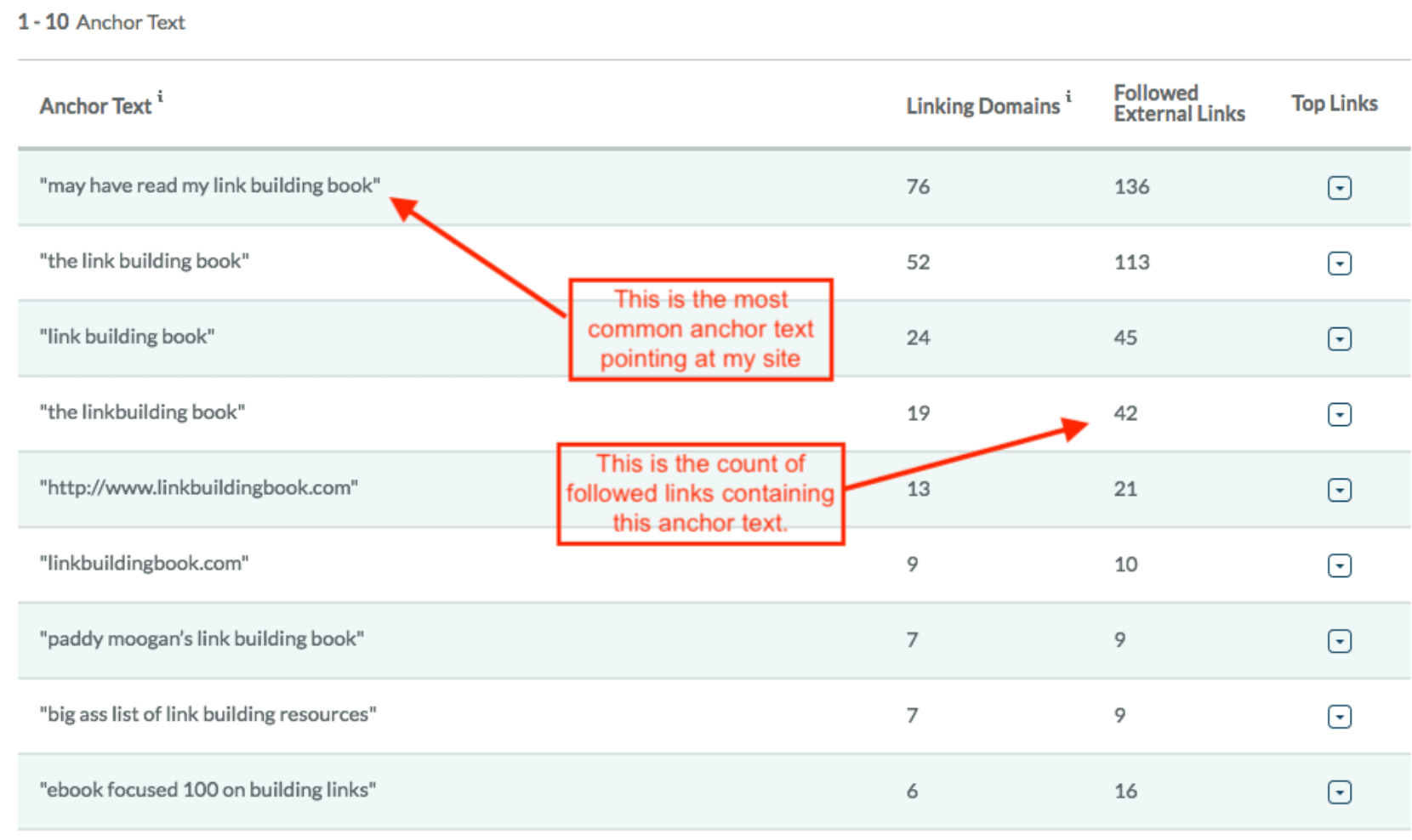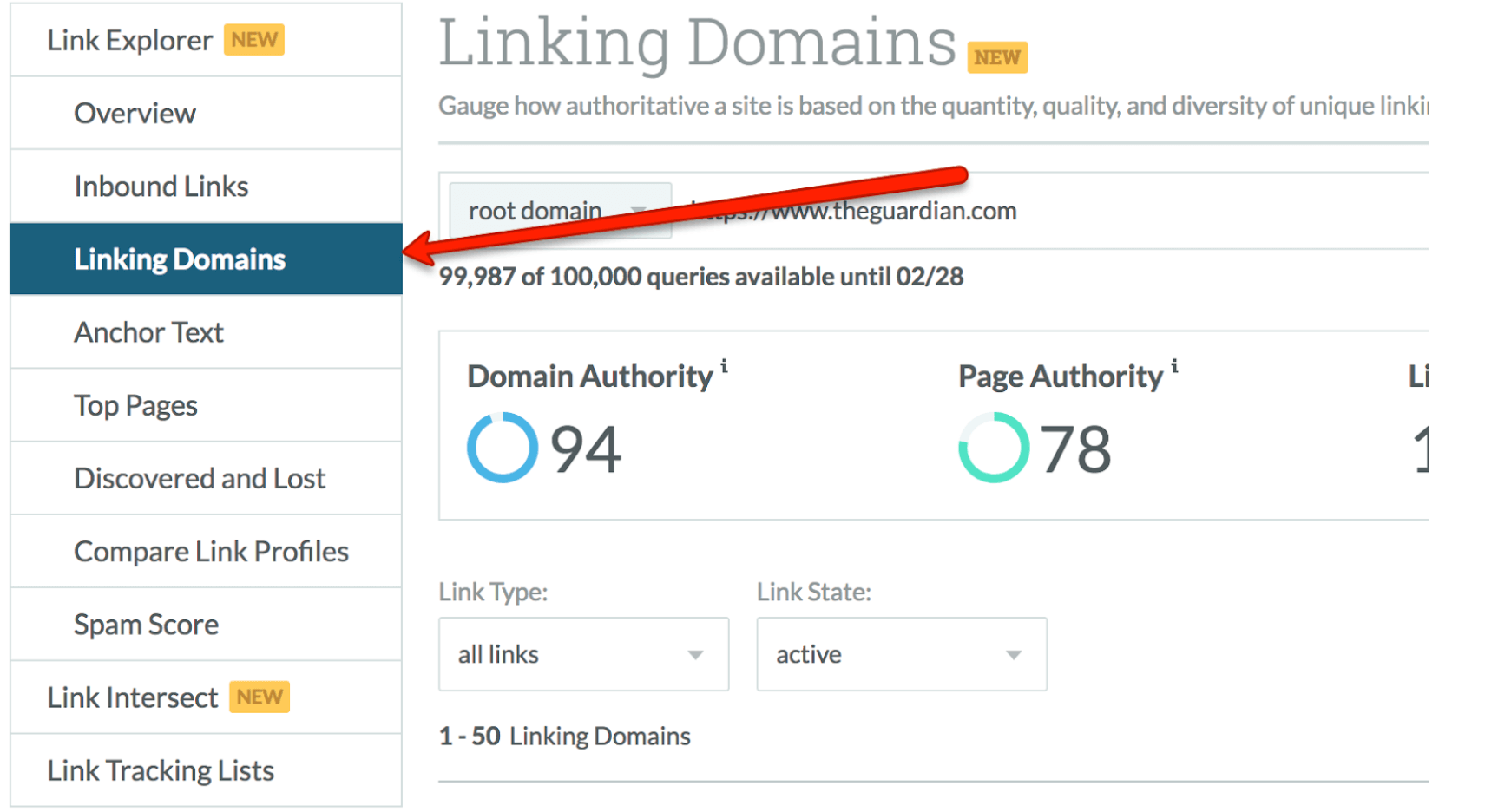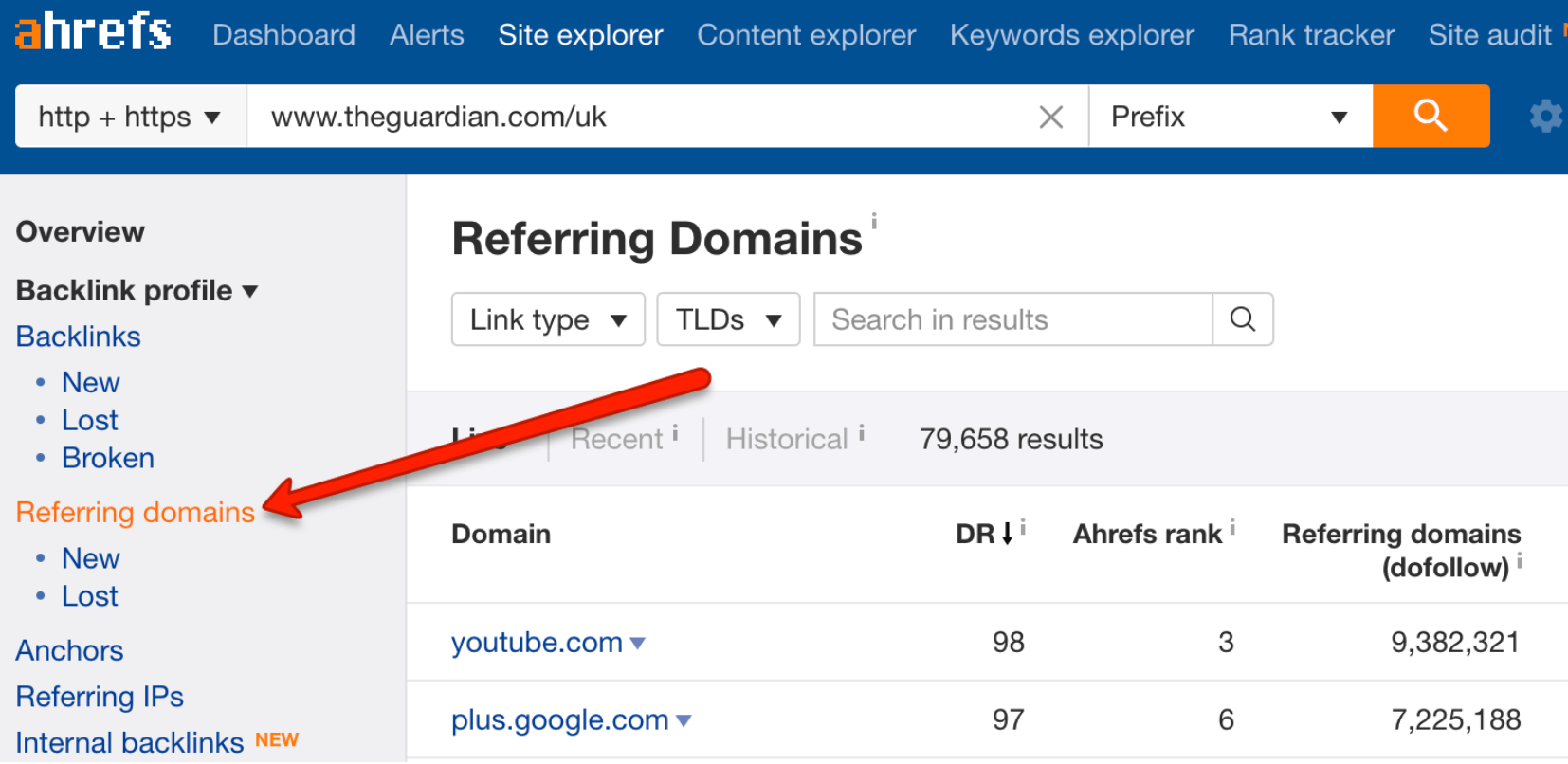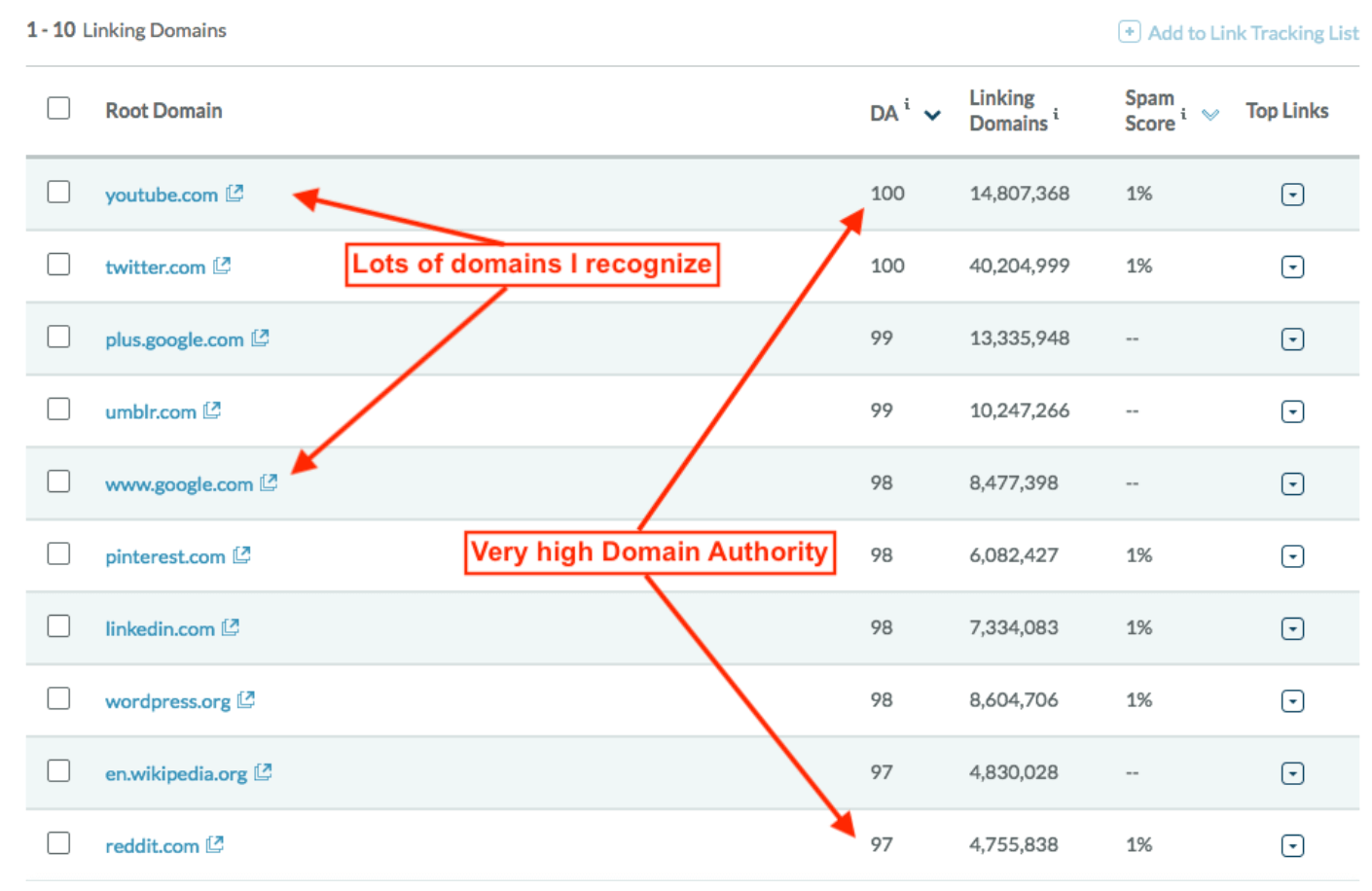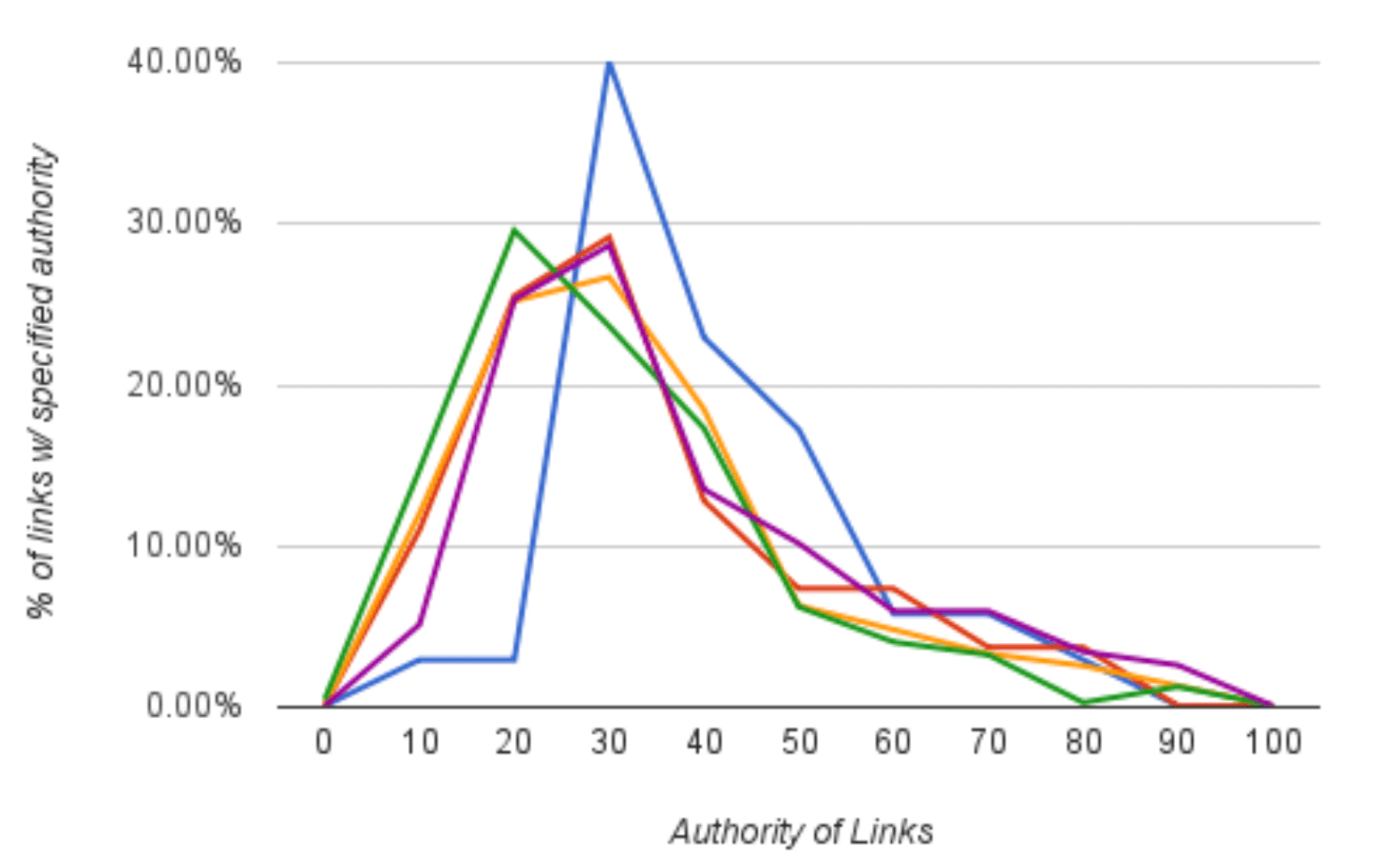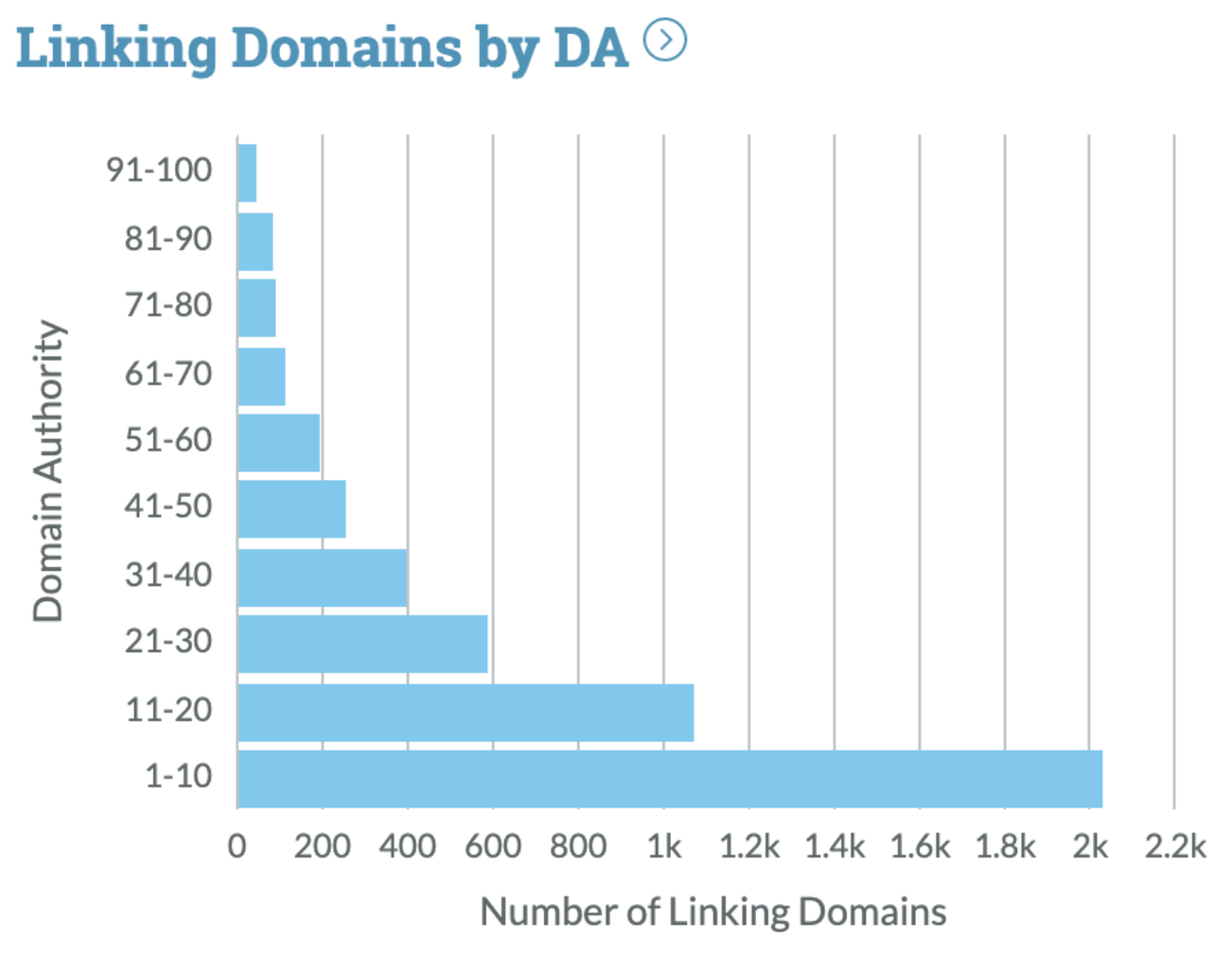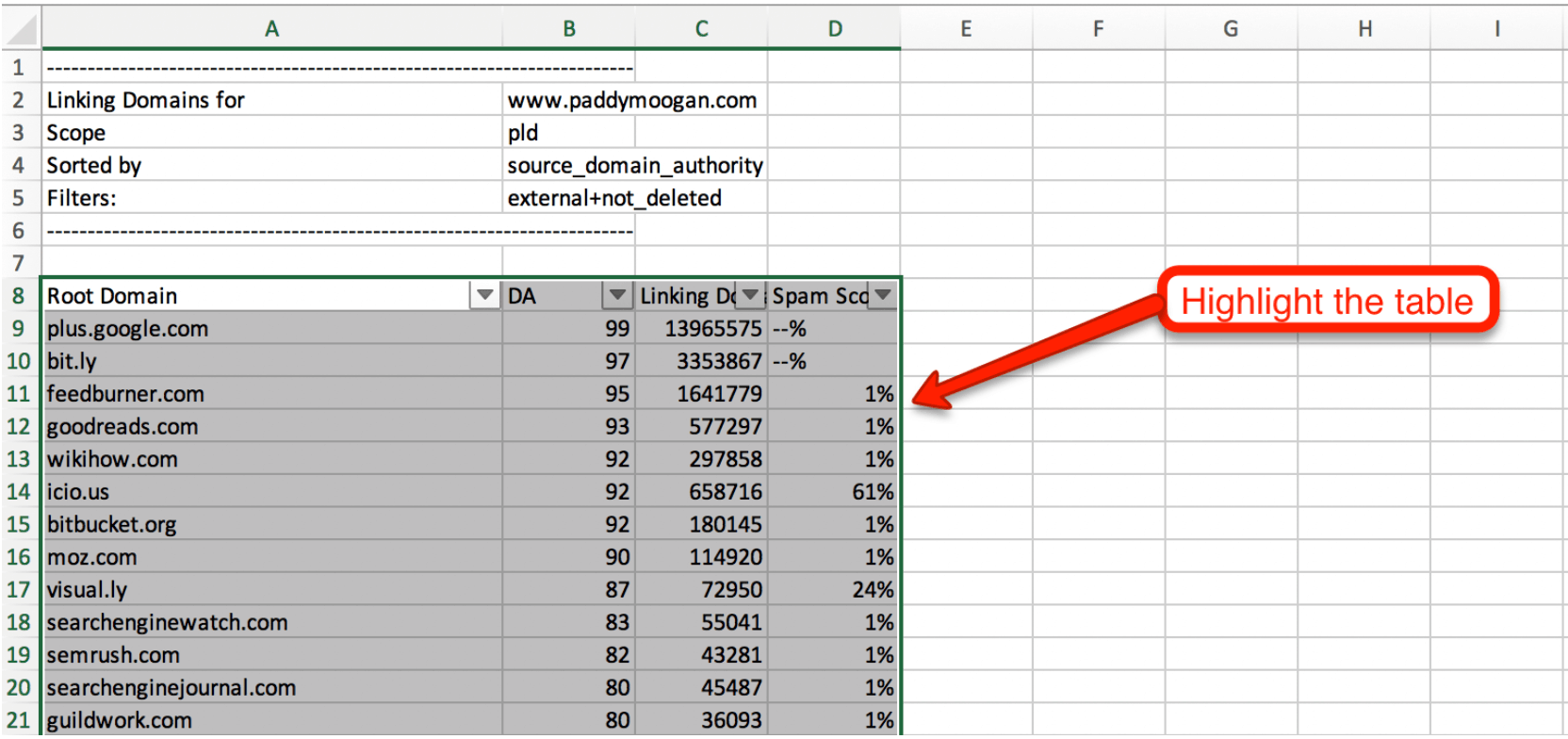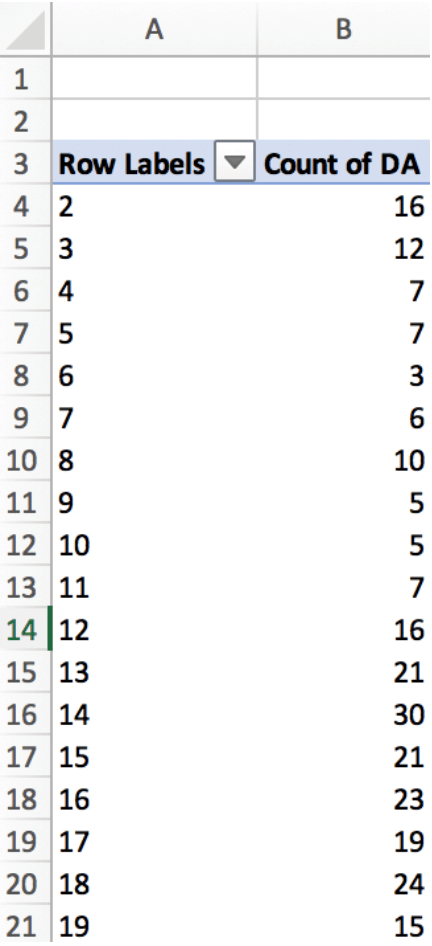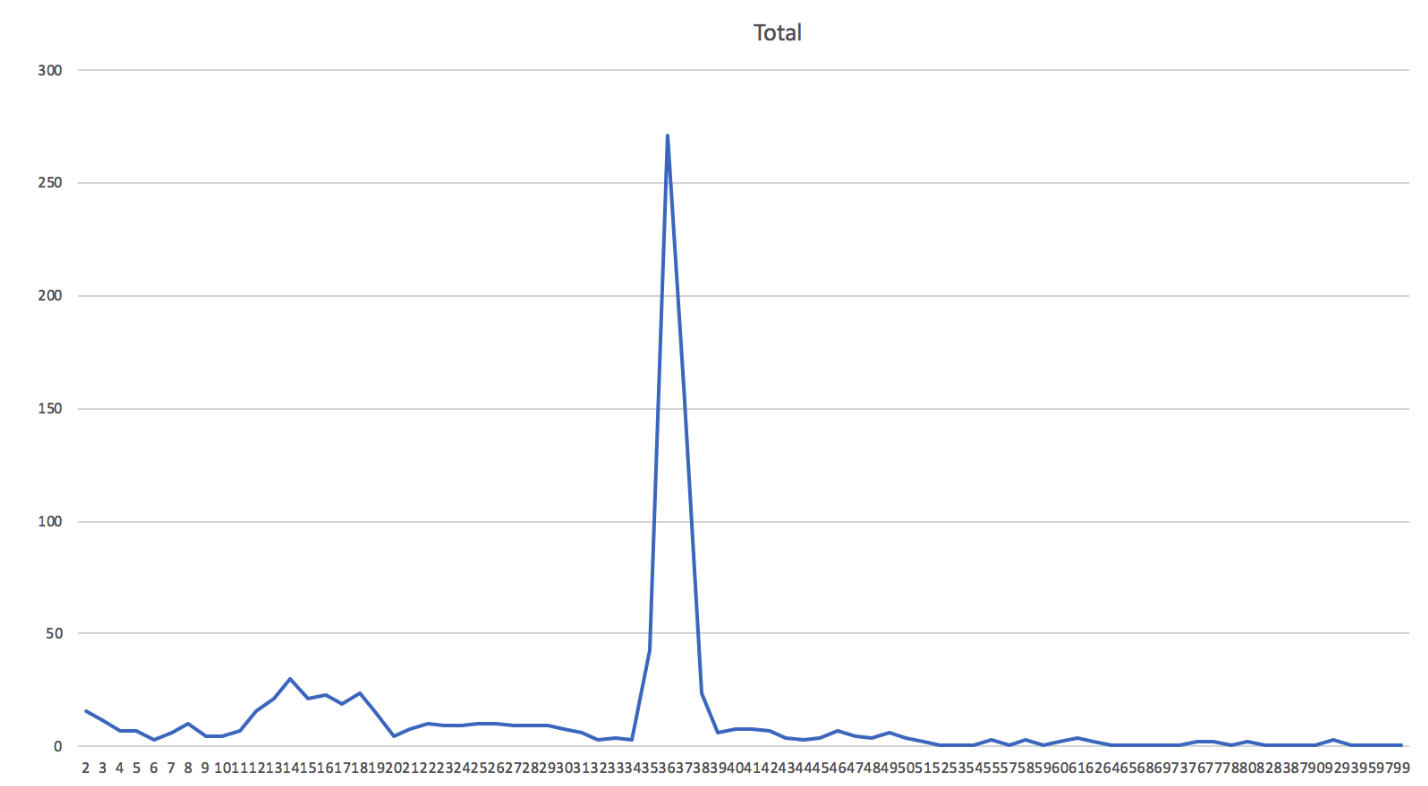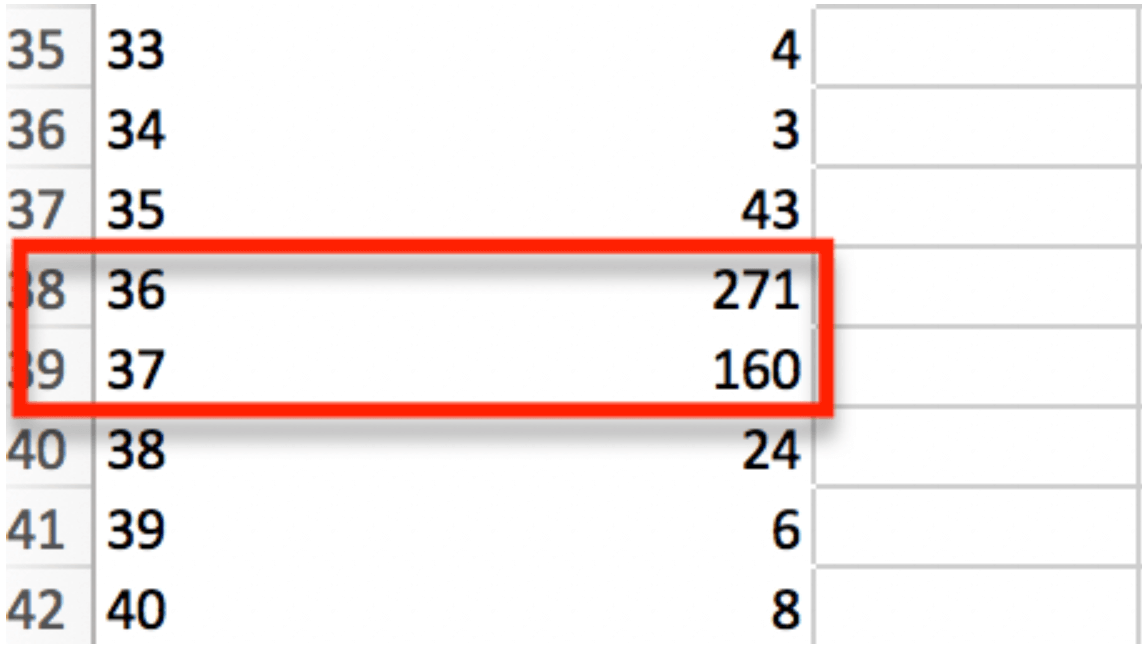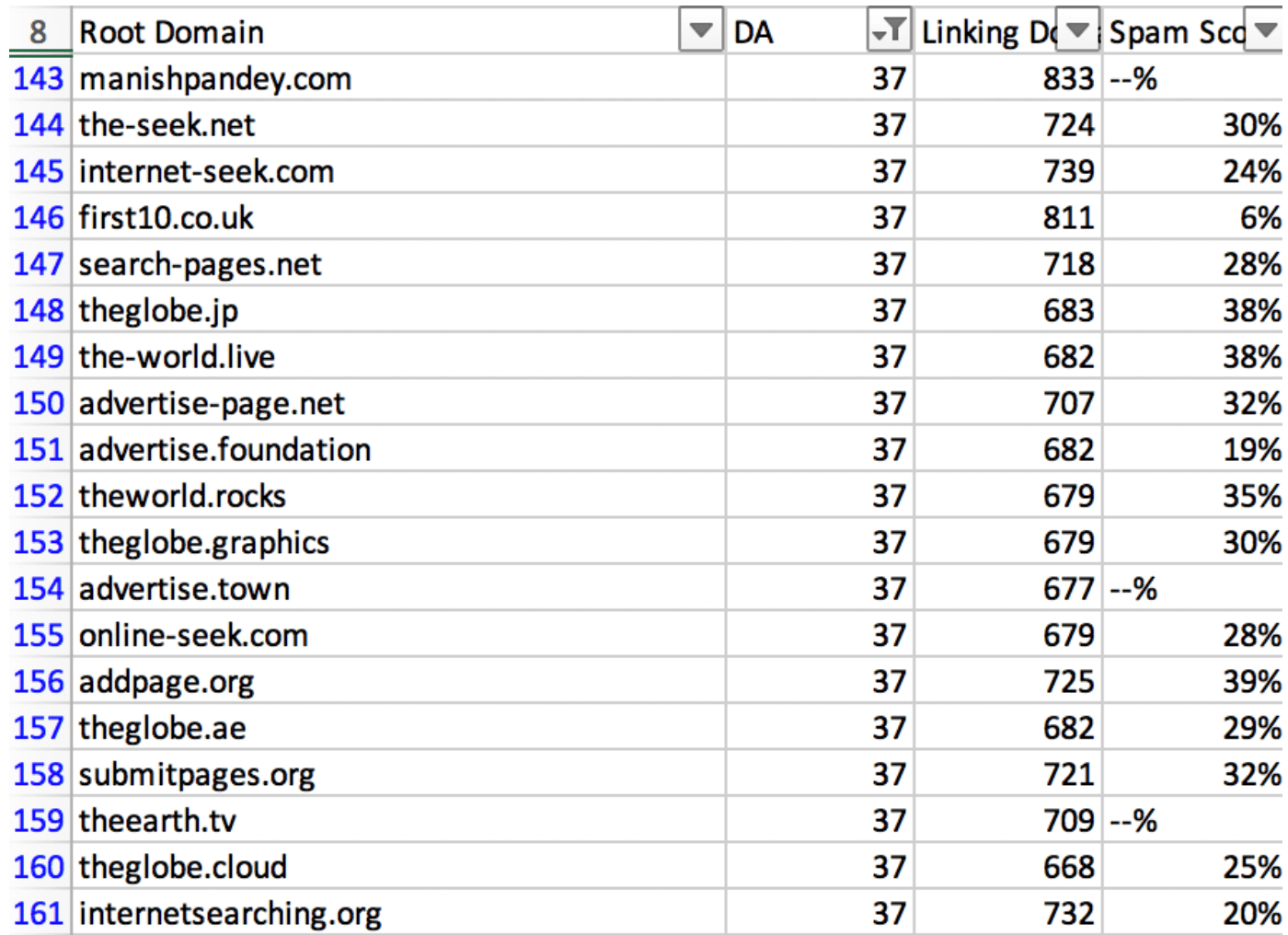Running analysis on your existing link profile and competitors
Analyzing your own link profile, and those of your competitors, should feed directly into your own link building strategy. You must carry out this analysis to see what you’re up against. Some industries are naturally more competitive than others. You need to know this information before you plan and execute your link building. If you don't, then you may never actually compete.
Having said that, I'm an advocate of actionable, competitive analysis. You could spend many days doing competitive link analysis (I have), but you need to make sure it eventually leads to solid actions for your own website. Otherwise, it can be a bad use of your time.
You also need to be able to spot potential problems with your own existing link profile and, if necessary, take steps to fix those problems – or, at the very least, not make them worse.
You can use a number of tools for link profile analysis. Personally, I feel that no single tool will give me all the information or answers I need to make decisions, so I tend to combine data from a few tools to get an overall picture of an industry.
How to analyze a link profile
A good link profile is one that looks as natural as possible and has a good balance of different types of links and anchor text. Google is actively trying to find links that are not natural and may actually be manipulative, so you should take the extra time and effort to build your presence properly which will lead to the types of links that Google wants to reward. Ultimately, you need to deserve the links that you get which will lead to a natural, well-rounded and robust link profile.
The following few sections will take you step by step through how to analyze a link profile. The advice in these sections will help ensure you spend your time wisely and your work leads to real actions. At the end of this section, I’ll briefly discuss what a “good” link profile may look like.
At the end of this link analysis, you should:
- Know any potential problems with your own link profile (i.e. you need to get more branded anchor text or links from a wider range of domains.
- Know which techniques you want to replicate from your competitors for quick wins.
There is a lot in this section. Everything can be used on your own link profile or competitors. But I want you to focus on actions.
What do you want to find out?
Start with this simple question: When you have completed this work, what do you want to have achieved? The answer will depend slightly on whether you’re doing link analysis of your own website or a competitor’s. But it should usually fall into one of these three areas:
- Find problems
- Find patterns
- Find opportunities
The first two are more applicable to your own website analysis if you’ve received some kind of link warning or penalty (this will be discussed in a later chapter). For now, let’s go into more detail about these three areas.
Find problems
As we’ve discussed in previous chapters, not all links are created equal, and some can actually harm your website. Therefore, it’s important to be able to find problem links and assess whether they might be hurting your website’s ability to rank well. If you find problem links and are confident that they are causing you problems with ranking, then you can try to remove those links or use the disavow tools provided by Google and Bing.
Find patterns
Finding patterns helps you find link footprints, which can greatly speed up your link analysis. It can also help you discover more links than the regular link analysis tools.
The ability to find link patterns also allows you to quickly find problem links because, in many cases, links that have the same patterns and characteristics are not 100 percent natural. For example, doing mass article syndication and directory submissions will often leave footprints behind, such as the snippet of text you use to link to you, or many directories may be owned by the same company and may be on the same hosting server.
There are sometimes legitimate reasons for having links with the same characteristics in your link profile (e.g., having a partnership with a group of companies that allows you to embed a widget on their websites). This will leave a pattern. However, if you’re doing it legitimately and you aren’t trying to game the system, it might not actually cause any ranking or penalty issues. It's also natural to pick up some low-quality links via other websites which scrape the web and republish content and links. These are generally nothing to worry about and will happen to most websites, but it's worth being aware of them.
Find opportunities
This is where link profile analysis can be truly actionable. Most of the opportunities will lie in doing analysis on a competitor’s link profile. However, looking at your own profile can reveal some opportunities (e.g., identifying links that point at broken pages, which you can try and fix or realign).
However, most of the time you will be able to find bigger opportunities by looking at the link profiles of your competitors. You can often dive into their links and see how they acquired them and, importantly, see if you can do the same.
Important note: While you can find good opportunities to mimic your competitors, this is not a good long-term or scalable tactic. You do not just want to get the links that your competitors have: you want to get links that they can’t get. Otherwise, how are you ever going to beat them?
Learning from your competitors and learning from what they do should only be one part of your efforts.
With all of this in mind, let’s dig a bit deeper and look at the key link metrics you should focus on when carrying out link profile analysis.
The key link attributes and metrics to focus on
There are a wide range of link attributes and metrics available to you, but there are a select few that can provide you with 95 percent of the insights you’ll need from link profile analysis. This section will explore these in detail and tell you exactly how to use them.
Anchor text
One of the first things I check, when looking at a link profile, is the anchor text distribution. Within a few seconds of looking at this, I can usually tell whether the website has:
- Actively been doing SEO.
- Been doing a bit too much SEO and anchor text targeting.
The following shows how to use several different tools to check the anchor text of a link profile:
Majestic:
Link Explorer:
Ahrefs:
What we care about here is the anchor text distribution across a website’s link profile. Anchor text distribution is simply the range of anchor text that is used, highlighting which ones are used the most. Let’s look at the anchor text distribution of my Link Building Book website using Link Explorer:
If we take a few seconds to glance over the anchor text used, we can see that a lot of it looks pretty natural. Most of them use the official name of the book and a few are the actual URL of the website.
Let’s contrast this with the following anchor text distribution for a website that is a payday loan affiliate:
There is no mention of a brand at all. Pretty much all of the top anchor text used contains “commercial” keywords (loans). This doesn’t look natural. You’d expect at least a few mentions of the brand name or unrelated anchor text.
This type of anchor text distribution could cause ranking problems because it doesn’t look natural to Google. The links to this website look like they have been built with just one intention: to help it rank for these particular keywords.
Linking root domains
The number of linking root domains is the number of unique websites that link to another website. This has been a good indicator of quality and has been found to correlate quite well with search rankings.
The reason for this is quite straightforward. Remember that Google likes to think of links as votes. If one website links to you once, then that is one vote for you. If the same website links to you again, this is still only one vote because it is from the same “person.” Whereas if you get two links from two different websites, that is two votes. Therefore having lots of different domains linking to you is a good signal that you have a good website that deserves to rank well – because lots of different people are linking to it, not the same person over and over again. That's not to say that getting links from the same domain over and over is a bad thing, quite the opposite, it can be a good thing if it's a good quality website. But it may not mean quite as much as the first time that a website linked to you.
When looking at a link profile, I tend to look at the number of linking root domains as a better signal of quality rather than the raw number of links. Here is how you can see this number using popular link analysis tools:
Majestic:
Link Explorer:
Ahrefs:
By looking at the list of linking root domains, you can quickly get an idea of the quality of websites that are linking. In general, with high-quality websites you will see a few linking domains that you recognize or have very high Domain Authority.
Here’s an example, using the BBC as an example:
There are lots of recognizable domains and all of them have very high Domain Authority. Within a few seconds, you can see that the BBC website is attracting many strong links.
Let’s contrast this with the following list of linking root domains from a website I won’t name:
I recognize a handful of domains. However, the rest don’t stand out to me. I can see just from the URLs that a few of these are publishers which may indicate a guest blogging or content marketing strategy. If these are showing up near the top of the list, this may be an indicator of a low-quality link profile and require further investigation. The Domain Authority isn’t too bad, but I’d certainly expect more linking domains with Domain Authority of 60+. It doesn’t necessarily mean that something is wrong, but it’s an indicator that I should take a closer look.
If this were my client, I’d be looking to work hard on improving the quality of the websites they get links from and definitely shift away from guest posts. If this was the link profile of a competitor, I’d quickly realize that there probably isn’t much to learn from or even think about trying on my own website unless some of the guest posts were very relevant and high quality.
IP addresses
Another factor to consider is the range of IP addresses that link to you. The principle is the same as already discussed (i.e., lots of different IP addresses linking to you means that lots of different people are voting for your website). But what about multiple websites that are owned by the same person? Or websites that are yours?
To try and discover if the same person owns a group of websites, Google uses a number of signals. One of which is the IP address where the domain is hosted.
Every domain that is connected to the Internet will have an IP address associated with it. This IP address is assigned by their hosting provider, who will have a number of IP addresses that they can use. Sometimes, groups of websites owned by the same person will use the same hosting company and will be assigned either identical or similar IP addresses. A similar IP address is one that is within the same C-class block.
To explain this, let’s look at the makeup of an IP address, which usually looks like this:
342.454.232.10
Each string of numbers is separated by a period. This period shows the different blocks of an IP address, so we can rewrite this IP address as:
AAA.BBB.CCC.DDD
Using the IP address 123.456.789.10, we can say that the numbers 789 are in the C-class.
Here is an example of two IP addresses that share the same C-class:
123.456.789.10
123.456.789.15
Notice how the only difference is in the final block. Many hosting providers will use IP addresses that share the same C-class block. This means that if you host multiple websites with the same company, they are likely to share the same C-class. This is why it is a good signal to Google that websites are owned by the same person.
Why does Google care about this?
Well if you have five websites that all link to each other, those links are not from anyone unique. They are just you linking to yourself. While there is generally nothing wrong with this, it isn’t as good as getting other website owners to link to you. Therefore, Google may decide to give these links less weight.
This isn’t a strict rule, though. Many hosting providers will offer shared hosting packages, which means you can share the same IP address with many other websites that are owned by other people. Therefore, Google will also look for other signals that a group of websites is owned by the same person. They can look for things like identical domain registration information, shared business addresses on each website, or even the same phone numbers. All of these signals combined can tell Google if the same person owns a group of websites.
To find this information, you can go to these sections of the following link analysis tools:
Majestic:
Ahrefs:
In terms of how useful this information is, it mainly helps for finding problems and patterns, as opposed to opportunities. If you’ve inherited a website with a shady history of link building and you want to find evidence of link networks, for example, this would be a good place to start.
If you find competitors with lots of links from the same C-class IP addresses, you probably shouldn’t worry too much aside from making sure you don’t target the same links, unless there is a legitimate reason and the links look to be good quality.
Sitewide links
Sitewide links are links that don’t just come from one page, instead they tend to come from multiple pages of the same website. This is usually because a link has been included somewhere in the website template, such as the header, footer, or sidebar. This means that every page on the website that uses that template will also include the link.
Sometimes, there are legitimate reasons to have these kinds of links in your profile, and a few of these probably won’t cause you too many problems. However, if the majority of your link profile consists of sitewide links, it can indicate that low-quality link building techniques have been used, or, even worse, that the website has been buying links.
Matt Cutts commented on sitewide links in 2012 in this video. Basically, he said that if Google sees links to your website from the same domain, there is a typically point where those links may stop passing as much value.
Spotting sitewide links is pretty straightforward, but it involves a little bit of digging and experience in order to tell if they are legitimate or not. You’ll need to look at the ratio of linking root domains to the raw number of links. Here’s how to do that:
Majestic:
Majestic also lets you drill a bit deeper into the websites that are linking to you the most, which may indicate sitewide links. You can get this data from the following section:
Link Explorer:
Ahrefs:
These numbers can give you a rough idea of how many “sitewide” links you have i.e. websites that link to you from every page on their site - often using a link in a templated element such as a sidebar or footer. There could be legitimate reasons for this, but sometimes, sitewide links can be a sign of paid links because many sellers will sell them in these templated elements. This is because for a long time, getting lots of sitewide links with your target keyword as the anchor text was very effective and scalable for improving rankings.
Looking at the ratio of linking root domains against raw number of links by itself may not be very insightful because, as explained earlier, there may be legitimate reasons for sitewide links. So you need to dive a little deeper into these numbers and see what they actually look like.
You can do this by going to the domains that link the most to see what the link actually looks like. This should tell you pretty quickly if the link is legitimate, looks like it has been bought, or was otherwise built using a shady tactic.
As an example, these are some legitimate sitewide links from the Football365.com website footer:
These links are on every page of the website, but these links are to other websites they own and official partner websites. There is the question of how much PageRank these links will actually pass because they are in the footer, but we’re not concerned about that here.
Let’s contrast this with this example of sitewide links:
These don’t look natural do they? In fact, they are linking out to very different websites that aren’t related to each other at all. They also use exact match keywords that could be classified as highly commercial. Some of the text isn’t even formatted correctly with mixes of lowercase and uppercase letters. They are listed in the blogroll section, which means the same links will be featured on any part of the website that uses this template (in other words, all of the website, most likely).
If one of these links was pointing to my website, I’d probably work on seeing if it was damaging my rankings. If it was, then I’d try to get it removed or use the disavow tools to try and discount it. If I saw this kind of activity from a competitor, I certainly wouldn’t try to mimic this technique.
Low Domain Authority linking root domains
Another key metric to look at is the Domain Authority of the linking root domains and, specifically, the distribution across your link profile.
Quick note here - there are various other metrics available for you to do this kind of analysis with. Majestic and Ahrefs both have their own metrics (TrustFlow and Domain Rating respectively) which aim to do a similar thing to Domain Authority. They all have pros and cons and it can often come down to personal preference as to which one you use. The process outlined below can be used for whatever metric you prefer. You can also use page-level metrics such as Page Authority instead of Domain Authority. There are pros and cons of both approaches which you can read more about in this post by Tom Capper who argues against the use of Domain Authority.
You can do this analysis in a number of ways with the help of various tools.
One of the easiest ways of doing this for Domain Authority is to use this simple Google Doc tool from Tom Anthony, who explains how to use it in this Moz post.
Using this tool, you can get a visualization of the Domain Authority distribution for one website:
You can also get a visualization of the Domain Authority for a number of websites compared to each other, which is where things can get a bit more interesting:
The tool normalizes the Domain Authority, which allows for a good comparison between websites that have different volumes of links. As you can see from the graph above, the blue line sticks out quite a bit from the other four websites, which indicates some kind of anomaly. This particular graph is actually from a previous SEO project where the client came to us with a link profile problem. Their profile was the blue line above, which clearly shows something strange was going on that needed further analysis.
Moz also does this within link explorer for a single domain:
Repeating the process in Excel
You can do the same for whatever domain metric you prefer using a little bit of Excel magic and your favourite link analysis tool. First of all, you’ll need to download a list of all domains that link to you. Here is how to do that for a few different tools:
Majestic:
Link Explorer:
Ahrefs:
I’ll show you an example using an export from Moz Link Explorer.
First, open up the Excel spreadsheet and highlight the table of data:
Go to the top and Insert > Pivot Table:
Then drag these fields into the boxes as shown below:
This is basically telling the pivot table to count each individual DA score that you have for each domain. It will tell you how many DA34 links you have, how many DA45 links you have and so on.
Initially, you’ll end up with a table that looks like this:
The next step is to visualise this data which you can do by highlighting the table, then going to Insert > Line Chart:
You’ll then end up with something like this:
I was secretly very happy to see such a spike because it illustrates why we do link analysis perfectly. This kind of spike in DA in a link profile is something that warrants further investigation. Usually, you’d expect a spike or a peak, but not quite as dramatic as this.
If I look at this further, I can see from the original table that there is a big spike in links with DA36 and DA37:
This is what caused the spike in our graph above. If we go back to the original table of data from Moz and filter links to just show these, we can see:
Drilling into this further, I can see a lot of links from “theglobe” domains which in reality, are this kind of website which basically exists to lists lots of other domains:
This is a large network of websites and it looks like my website has somehow become listed on all of them.
They are all very similar to each other and share similar DA metrics - 36 and 37 which is the main cause of that spike that we saw above.
Having looked at this further, we can decide whether this is a problem or not. In this case, it’s unlikely to be a problem because the domain I’m checking doesn’t appear to be suffering from any penalties or ranking problems. Also, while these websites don’t appear to be the best kinds of websites, they are not the worst either. If this was a network of super spammy porn websites, then I’d definitely be more worried!
The key point to take away here is that the process above can let you spot anomalies in your link profile which warrant further investigation. It won’t give you the perfect answer, but it will point you in the right direction to check if something is potentially a problem or not.
Most linked-to content
One piece of actionable link analysis is to see which pages on a competitor’s domain are most linked to. You do have to exclude obvious pages, such as the homepage and top-level categories, and what remains can often be content pages. You can then go and take a look at this content and try to determine what makes it link-worthy. Sometimes you can learn from this and create some content of your own, which is similar, or, ideally, better!
Here is how to find the most linked-to pages using the following tools:
Link Explorer:
Majestic:
While finding opportunities from competitors is a good way to use this technique, there is some opportunity in running this report on your own website, too. You may find some incoming links pointing at pages that are actually broken. This is a waste of valuable link equity and fixing it can help make those links count again.
You can also check for pages being linked to that 302 redirect. A 302 redirect doesn’t pass link equity so it is usually worth changing it to a 301 redirect, unless there is a legitimate reason for having a 302 redirect.
You can simply check the HTTP status codes of the pages that have incoming links:
Link Explorer:
If you find broken links or 302 redirects, you can either fix those or ask whoever is linking to the page to change the link so that it points to the right page. In reality, it is usually easier to fix the page yourself, typically by adding a 301 redirect to a relevant page which will pass most of the link equity.
Nofollow attribute
As we mentioned earlier, the nofollow attribute is a tag that can be added to the code of a link. For the users, they do not notice any difference in the way the link looks or behaves. But when the search engines crawl the link, they will see the nofollow tag, which tells them not to pass any link equity to the page being linked to. Basically, it tells the search engines not to count that link in their link graph and therefore, the link shouldn’t affect rankings.
In 2005, Google, Yahoo, and MSN (now Bing) united in their handling of the nofollow attribute, said that they’d all honor it when crawling the web.
The tag itself will look something like this if you look at the code of a webpage:
<a href="”http://www.example.com”" rel="”nofollow”">Example</a>
The rel=”nofollow” is the important bit here and makes the link different to standard links.
The main reason for a website to use the nofollow tag is to tell the search engines when they can’t trust the website being linked to. This may sound a bit strange at first, but there are many instances where users can link to their own websites without the website owner endorsing the link. A few examples of this would be:
- Blog comments
- Forum posts
- Guestbook entries
- User-generated pages, such as social profiles
These places have traditionally been targets for some SEOs to get easy links from, but the addition of the nofollow attribute to these kinds of links can help discourage them because no link equity will pass anyway.
Google also advises that any links that are in any way incentivized, should be marked with the nofollow tag. This means that no PageRank will be passed across and therefore, incentivized links will not affect rankings. This also applies to advertising banners. In reality, SEOs who buy links will actually make sure that the links do pass link equity because they wouldn’t buy them otherwise.
In September 2019, Google announced an update to how they interpret the nofollow attribute, as well as announcing support for two new, similar attributes. In addition to nofollow, webmasters can also use two more:
- rel="sponsored"
- rel="ugc"
So in total, there are now three possible attributes that a webmaster can use to declare a link as something they may not trust. Since 2005 when nofollow was originally introduced, the attribute has been used in a number of ways which has led to Google splitting things out to a more granular level so that webmasters can be more specific around their use of the attributes.
In terms of what each one is designed for, rel="ugc" is designed for links contained in user-generated content (UGC). Examples being forums and blog comments which contain external links.
The rel="sponsored" attribute is designed for a webmaster to declare a link which has been paid for, perhaps via an advertisement or an exchange of products.
When it comes to link building, the key thing to remember here is that whichever attribute is used on a link, Google may or may not decide to count that link in their link graph and therefore, toward rankings. In Google’s words:
All the link attributes -- sponsored, UGC and nofollow -- are treated as hints about which links to consider or exclude within Search. We’ll use these hints -- along with other signals -- as a way to better understand how to appropriately analyze and use links within our systems.
Given the recency of these developments, most SEO tools are still updating how they handle and report on the two new attributes. For now, here’s how you can find nofollow links in Majestic and Link Explorer:
Majestic:
Link Explorer:
Ahrefs has added the feature to filter links by the new attributes:
This data isn’t massively actionable and rarely will you be able to change a nofollowed link into a followed link. If you are running this analysis on your own site, you should certainly make sure that you’re generating plenty of links that are followed because these are the ones that will matter.
You should also be aware of this when you’re building links. You should check that a website actually follows external links. You can do this easily using a number of browser add-ons, one being the MozBar which will highlight nofollow links in purple:
These blog comment links on the Moz blog are highlighted in purple, which means they have the nofollow tag applied to them.
There is one other thing to remember here: the nofollow tag can be applied at the page level as well as the individual link level. In fact, originally the nofollow tag was only able to be applied at the page level as a meta tag, which looked something like this:
<meta name="robots" content="nofollow" />
This tag would be included in the head section of the HTML and meant that every link on the page would be nofollow.
What a good link profile should look like
There isn’t a perfect answer to this, but it is something that I get asked about quite a lot, so I wanted to address it. I’ve highlighted a number of things above that would make me a bit suspicious when looking at a link profile, but, to summarize and say what a good profile would look like to me, I’d say:
- Most of the most popular anchor text is branded, not commercial keywords
- There are links which are clearly natural and weren't asked for
- Links containing natural text such as “this website”
- Lots of linking root domains, not just raw links
- Links to deep pages, not just the home page
- Diversity in types of links (e.g., some links from guest blogs, industry associations, newspapers, and customer reviews); not all from one source (e.g., guest blogging)
- Some nofollow links and a few links from domains with low-quality metrics
- Links from images
- Links that go via redirects
To summarize, remember what we looked at early on in this book when discussing the broad elements of good links:
- Trust
- Relevance
- Diversity
If your link profile has a nice balance of all three, you are probably doing well and do not need to worry.
Ultimately, ask yourself this question: if someone from Google’s webspam team looked at this link profile, would that person get suspicious and take a closer look? If the answer is yes, then you may want to work on cleaning up some of the bad links and building some better ones!
At the end of this link analysis, you should:
- Know any potential problems with your own link profile (e.g., you need to get more branded anchor text or links to deep pages)
- Know which techniques you want to replicate from your competitors for quick wins
Don't have time to read the book now? Take it away with you in either a pdf or download our Kindle version



